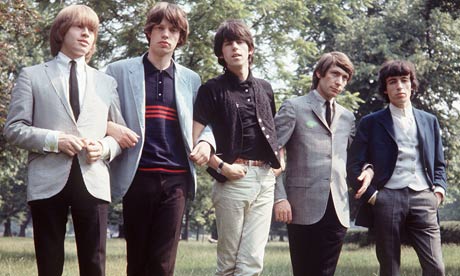
Popular culture gobbles up its favourites and almost immediately spits them out, so how come the Rolling Stones – who until very recently still creakily cavorted through ghoulish parodies of the songs they composed half a century ago – haven't been expelled into oblivion? Mick Jagger now dyes his hair a fetching shade of chestnut; Keith Richards, having miraculously survived the decades in which he used his body as a lab for testing toxins, looks, as Elton John cattily put it, like "an arthritic monkey". Yet the more grotesque they become, the more fondly we tolerate their prolonged adolescence.
Their music has little enough to do with it. As Christopher Sandford comments in his fine biography of the group, they peaked creatively in the mid-1960s and everything since then has been a matter of scrupulous, mercenary "decline management". The decline, however, is shared with their ageing fans. Their original appeal, as the New York Times pointed out in 1972, was as a scandalous symbol of "generational independence"; now that we baby-boomers are too rickety to do much dancing, the Stones serve as a precious relic of our teenage days. Encouraged by them, we can all grow old disgracefully.
Following them through 50 years, Sandford shows how a world they once promised to transform with their blasting amps and their demands for satisfaction gradually took them captive. Their agenda, at first, entailed radical change. As a boy, Jagger had a chemical set with which he announced that he intended to blow up the world. Marianne Faithfull, described by Sandford as the band's "concubine", sweetly added that she'd "like to see the whole structure of society collapse", with LSD replacing Christianity as an official opiate. Much later, Richards smugly remarked that the Stones personally "tore down the Berlin Wall".
When they performed in Prague in 1990, Václav Havel shimmied into a pair of leather pants in their honour and the licking tongue that was their logo replaced a statue of Stalin in the hills outside the city. But in fact the Stones were middle-class kids who had no intention of fomenting revolution; at best, they stirred up riots, like the one at Altamont outside San Francisco in 1969, when a gang of Hell's Angels clubbed the crowd into submission with pool cues and stabbed a young black man to death.
Richards liked to grouse that "the establishment – a lot of fuckin' judges and politicians – kicked us out of our own country". But they spent their exile in the 1970s happily trashing chateaux in the south of France, and Sandford astutely points out that it was their own highly paid accountants who made the long tax holiday necessary by mismanaging their affairs.
Jagger, a dropout from the LSE, proved to be an exemplary capitalist, grimly tight-fisted with both lovers and colleagues. By the 1990s, the purpose of the band's tours was, as one of their advisers put it, to "generate merchandise awareness". Their cunnilingual emblem now slavered over wallets, glasses, T-shirts, belt buckles and, of course, women's panties; the Stones pocketed $5m when they licensed "Satisfaction" – once interpreted as an anti-consumerist anthem – as an advertising jingle for Snickers chocolate bars.
In the beginning, rock music boasted that it was sponsoring a classless Britain. The Stones took a bumptious delight in buying their country estates from down-and-out aristocrats, though soon enough they reconstituted the ancien régime. Charlie Watts retained a chauffeur to ferry him around in a Mini. Jagger did his social climbing horizontally; not content with the groupies called Susie Suck and Kathy Kleevage, he graduated to "hobnobbing", as Sandford delicately puts it, with Princess Margaret.
Whether for services to music or to her sister, the Queen knighted him in 2003, which prompted Richards to refer to him as "His Royal Fucking Highness". Given this regal status, it was perhaps a little risky for Jagger to celebrate one of his birthdays with a French Revolution-themed costume ball. But Jerry Hall, cast as Marie Antoinette, explained that the decorative guillotine was intended "for the press".
Sandford gamely makes his way through the binges and the arrests, the marital break-ups and the internecine feuds, and finds an uproarious comedy in the luxuriant squalor and knockabout chaos of it all. Jagger, drunk, once telephoned Charlie Watts's hotel room at 5am and demanded to speak to "my drummer". Watts rose from bed, meticulously showered and shaved, dressed himself in a three-piece suit, then took the lift downstairs and decked Jagger for impertinence.
The fraternal rivalry between Jagger and Richards is the book's recurring motif. Keith sneers at Mick's foppery onstage and compares him, with his feather boas and glittery capes, to "fucking Danny La Rue". Whenever Mick brandishes his calculator and calls a meeting to order, the semi-comatose Keith jeers at "Mr Jogger".
The collaboration or collision of their musical styles – "Mick's dance-hall grooves and Keith's bluesy shuffles" – may have been responsible for the unique sound of the Stones, but it's clear where Sandford's sympathies lie. Richards emerges as a grand and gloriously funny eccentric, physically wasted but mentally spry, while Jagger dwindles into a satyr with the soul of a bank manager.
Despite his priapic reputation, Sandford passes on a groupie's confidential comment about the Jagger penis; he also remarks, after the split with Jerry Hall, that "even a grand passion rarely compensates for a five-inch difference in height". No man is a hero to his biographer: Jumping Jack Flash turns out to be a wizened pygmy.

